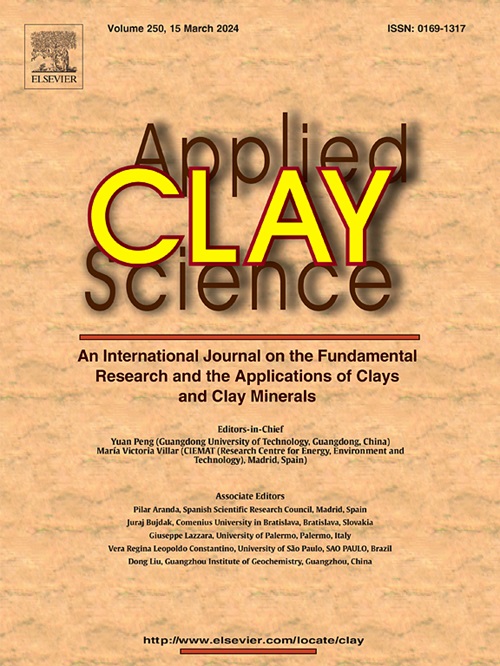具有长度和大小选择性的层状双氢氧化物对DNA亲和力的尺寸精度
IF 5.8
2区 地球科学
Q2 CHEMISTRY, PHYSICAL
引用次数: 0
摘要
在这项研究中,我们证明了脱氧核糖核酸(DNA)链选择性地结合到尺寸定制的层状双氢氧化物(LDH)颗粒的表面,这是由吸附质和吸附剂之间独特的尺寸匹配相互作用驱动的。合成了具有特定粒径的高纯度LDH-S(小)和LDH-L(大),并对其DNA吸附行为进行了系统的研究。LDH-S比LDH-L具有更高的比表面能和zeta电位;而与LDH-S相比,LDH-L在晶体学ab平面上具有有序的晶体结构。根据吸附等温线,DNA链以多层方式吸附在LDH表面。数学拟合结果表明,LDH-S比LDH-L具有更高的吸附容量和更少的协同吸附。用尺寸特异性阶梯DNA电泳证实LDH以尺寸选择性的方式吸附DNA;低于800碱基对的阶梯DNA选择性吸附在LDH-S上,而高于800碱基对的DNA优先吸附在LDH-L上。利用大质粒DNA结合实验证实,LDH-L对大片段DNA具有较好的吸附效率。LDH-L对大型DNA的独特偏好可能是由于具有周期性静电相互作用位点的膨胀表面上DNA链之间的合作相互作用。本文章由计算机程序翻译,如有差异,请以英文原文为准。
Dimensional precision in DNA affinity by layered double hydroxides with length and size selectivity
In this study, we demonstrated that deoxyribonucleic acid (DNA) strands selectively bind to the surfaces of size-customized layered double hydroxide (LDH) particles, driven by a distinct size-matching interaction between the adsorbate and adsorbent. High-purity LDHs with specific particle sizes – LDH-S (small) and LDH-L (large) – were synthesized, and their DNA adsorption behaviors were systematically examined. The LDH-S exhibited a higher specific surface energy and zeta potential than LDH-L; whereas LDH-L possessed a well-ordered crystalline structure along the crystallographic ab-plane compared to LDH-S. According to the adsorption isotherm, the DNA strands were adsorbed onto the LDH surface in a multilayer manner. The mathematical fitting indicated that LDH-S had a higher adsorption capacity and less cooperative adsorption than LDH-L. Electrophoresis using size-specific ladder DNA confirmed that LDH adsorbed DNA in a size-selective manner; ladder DNA below 800 base pairs selectively adsorbed on LDH-S, while DNA above 800 base pairs preferred adsorption on LDH-L. The binding assay using large plasmid DNA corroborated that LDH-L displayed superior adsorption efficiency for large DNA fragments. The distinctive preference of LDH-L for large DNA might be due to cooperative interactions among DNA strands on expansive surfaces with periodic electrostatic interaction sites.
求助全文
通过发布文献求助,成功后即可免费获取论文全文。
去求助
来源期刊

Applied Clay Science
地学-矿物学
CiteScore
10.30
自引率
10.70%
发文量
289
审稿时长
39 days
期刊介绍:
Applied Clay Science aims to be an international journal attracting high quality scientific papers on clays and clay minerals, including research papers, reviews, and technical notes. The journal covers typical subjects of Fundamental and Applied Clay Science such as:
• Synthesis and purification
• Structural, crystallographic and mineralogical properties of clays and clay minerals
• Thermal properties of clays and clay minerals
• Physico-chemical properties including i) surface and interface properties; ii) thermodynamic properties; iii) mechanical properties
• Interaction with water, with polar and apolar molecules
• Colloidal properties and rheology
• Adsorption, Intercalation, Ionic exchange
• Genesis and deposits of clay minerals
• Geology and geochemistry of clays
• Modification of clays and clay minerals properties by thermal and physical treatments
• Modification by chemical treatments with organic and inorganic molecules(organoclays, pillared clays)
• Modification by biological microorganisms. etc...
 求助内容:
求助内容: 应助结果提醒方式:
应助结果提醒方式:


